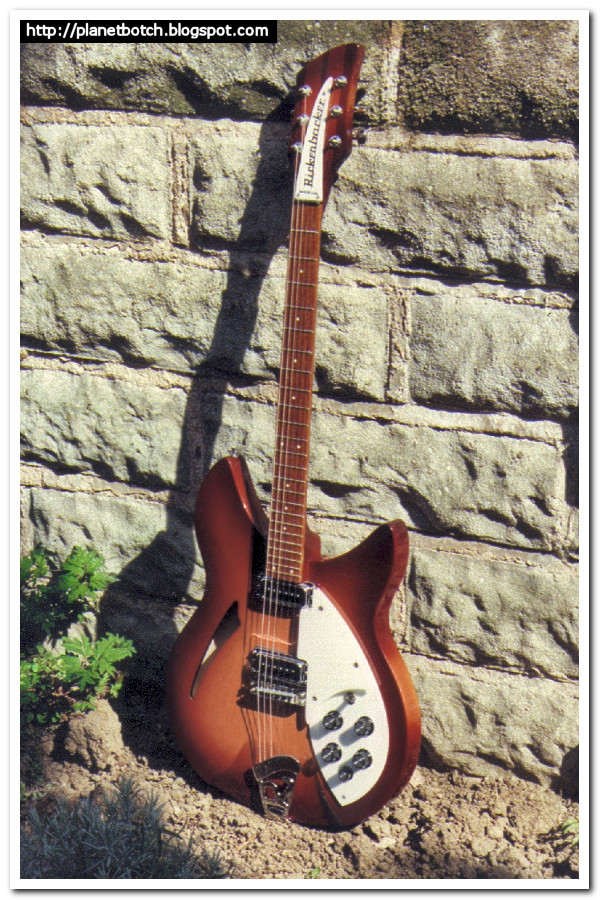The Rickenbacker 330 Guitar stands as a true icon in the world of electric guitars, instantly recognizable for its distinctive jangle and stylish aesthetic. My own journey with this remarkable instrument began back in 1988, when I walked out of Tempo, a guitar shop in Hanwell, London, with a brand new, fireglo Rickenbacker 330. This purchase, funded in part by the sale of my Yamaha DX7 synth, marked the beginning of a long and rewarding relationship with a guitar that has consistently defied trends and exceeded expectations. Dating back to November 1987, thanks to its serial number K0 7268, this guitar has been a constant companion in my musical exploration.
 Vintage Fireglo Rickenbacker 330 Electric Guitar
Vintage Fireglo Rickenbacker 330 Electric Guitar
Overcoming Preconceptions: Why the 330 Stood Out
Interestingly, my decision to buy the Rickenbacker 330 guitar came despite having read a rather unfavorable review. In an early 80s book, The Complete Guitar Guide, the reviewer dismissed the 330 as lacking versatility and poor value for money, awarding it a mere 15 out of 25 stars. However, I’d learned to take such reviews with a grain of salt, especially considering the same reviewer had lauded guitars I found utterly uninspiring. My own ears and eyes told a different story.
What truly drew me to the Rickenbacker 330 were the bands and musicians I admired who wielded this iconic instrument. From the sharp, energetic chords of The Jam and The Who, to the shimmering melodies of The Smiths and REM, and not least, the captivating presence of Susanna Hoffs of The Bangles, the 330’s sound was indelibly linked to the music I loved. In a market saturated with Stratocaster clones, the distinctive look and sound of the Rickenbacker stood apart, promising something unique. The allure of a guitar that evoked Susanna Hoffs was, frankly, irresistible, regardless of any lukewarm reviews.
Rickenbacker Craftsmanship: A Testament to Tradition
Rickenbacker’s commitment to traditional craftsmanship is a cornerstone of their guitars, and the 330 is no exception. Unlike the bolt-on neck construction common in Fender-style guitars, the Rickenbacker 330 guitar features a set neck, indicative of a more traditional and labor-intensive approach. This dedication to time-honored methods results in instruments of exceptional quality, built by luthiers who clearly possess a deep understanding of their craft.
While Rickenbacker now suggests they’ve moved away from cellulose finishes, my 1987 model undoubtedly boasts this classic finish. The fireglo finish on my Rickenbacker 330 is remarkably thin and flawlessly smooth, aging gracefully over the years to a softer sheen while retaining its original depth and richness. This finish not only enhances the guitar’s visual appeal but also contributes to its resonant qualities.
The Neck: A Slim and Fast Playing Experience
The neck profile of the Rickenbacker 330 guitar is a defining characteristic and may surprise players accustomed to Gibson or Fender instruments. It’s remarkably slim with a narrow fingerboard crafted from African rosewood, a timber with a lighter hue than typical rosewood. Interestingly, while technically rosewood, its hardness and tonal properties are closer to maple. Adding to its unique feel, the rosewood fingerboard is finished with a clear gloss cellulose, creating a playing surface that feels remarkably like maple despite its rosewood appearance.
Access to the upper frets on the Rickenbacker 330 is exceptional, surpassing even that of a Stratocaster. The neck joint meets the body around the 21st fret, compared to the Strat’s 16th fret join. While navigating the higher frets can be challenging due to the narrow string spacing, this compact neck can be advantageous for players with smaller hands or those who favor intricate chord work. Pete Townshend himself noted how the Rickenbacker neck inspired him to develop new chord voicings, contributing to his iconic and innovative playing style. He famously quipped about the Rickenbacker neck’s unique feel compared to more traditional guitars, highlighting its distinctiveness.
Body and Tone: Semi-Acoustic Resonance
The body of the Rickenbacker 330 guitar is notably slim, thinner than a Gibson ES-335, resulting in smaller acoustic chambers. However, the high-quality maple construction contributes to a surprisingly resonant and pleasing acoustic tone. In fact, unplugged, the 330 exhibits a louder and, to my ear, more appealing acoustic character than many typical semi-solid guitars, including the ES-335. While not intended as a purely acoustic instrument, this unplugged resonance is a strong indicator of the quality of the tonewoods used. A guitar that sings acoustically is more likely to excel when amplified, allowing the pickups and amplifier to truly bring out its inherent tonal qualities. And indeed, the Rickenbacker 330 guitar and a good valve amplifier are a match made in tonal heaven.
Hi-Gain Pickups: The Signature Rickenbacker Jangle
The Rickenbacker 330 guitar is equipped with Rickenbacker’s renowned Hi-Gain pickups. These single-coil pickups are wider and wound hotter than traditional Fender Stratocaster pickups, delivering a thicker, more robust sound. The magic of the 330 lies in its distinctive voice, a character that transcends mere pickup design and is deeply rooted in the instrument itself. Even unplugged, the inherent personality of the Rickenbacker 330 is evident.
The sound of the Rickenbacker 330 guitar is instantly recognizable and unlike any other. It’s a sound often described as “jangly,” but with a warmth and body that prevents it from being thin or brittle. This unique sonic signature is a key reason why players are drawn to Rickenbackers. While you might modify a Stratocaster in countless ways, you simply cannot replicate the authentic Rickenbacker tone. If that distinctive jangle, with its inherent character and richness, is what you seek, then a Rickenbacker is essential.
A Lasting Legacy of Individuality and Quality
The Rickenbacker 330 guitar has always occupied a unique niche in the guitar world. It’s not a guitar for everyone, and its distinctiveness can be polarizing. However, to dismiss it based on its niche appeal is to overlook its iconic status, exceptional build quality, and unwavering commitment to individuality. In an industry often driven by cost-cutting and mass production, the Rickenbacker 330 stands as a shining example of enduring craftsmanship and a refusal to compromise on quality.
My initial apprehension about the Rickenbacker 330 guitar, fueled by a negative review, proved to be completely unfounded. Far from being poor value for money, I believe the £549 I paid in 1988 was an exceptional investment in a truly unique and meticulously crafted instrument. The Rickenbacker 330 is more than just a guitar; it’s a statement of individuality, a testament to quality, and an enduring icon of rock and roll history.
While it took some time to fully adapt to the Rickenbacker 330 guitar‘s unique neck and playing feel, this adaptation proved to be a creative catalyst. The 330 often encourages playing styles and musical ideas that might not emerge on other guitars. This inherent character is perhaps why bands associated with Rickenbacker are often musically distinctive and innovative. Would the unique guitar riffs and sonic landscapes associated with Rickenbacker-wielding artists have come into existence had this exceptional instrument never been created? It’s a question worth pondering, and my answer leans firmly towards “no.” The Rickenbacker 330 guitar is not just an instrument; it’s an inspiration.

